The Complete Guide to Setting the Perfect Table for Any Occasion
True or false?
– Setting a formal table means using expensive china.
– Setting a casual table means using plastic utensils.
If you answered true to one or both of these statements, then you need to brush up on your table setting knowledge and you need to read this blog post!
Setting a table may seem simple, but proper place setting can elevate any dining experience. Whether you are hosting a dinner party or just having a family meal, knowing how to set a table correctly is essential.
Picture a beautifully set table—the plates, cutlery, and glassware all perfectly placed in harmony. A well-set table not only sets the tone for a meal but also enhances the overall dining experience. So, let’s break down the basic steps to table setting to help you set a table like a pro.
How to Prepare the Table
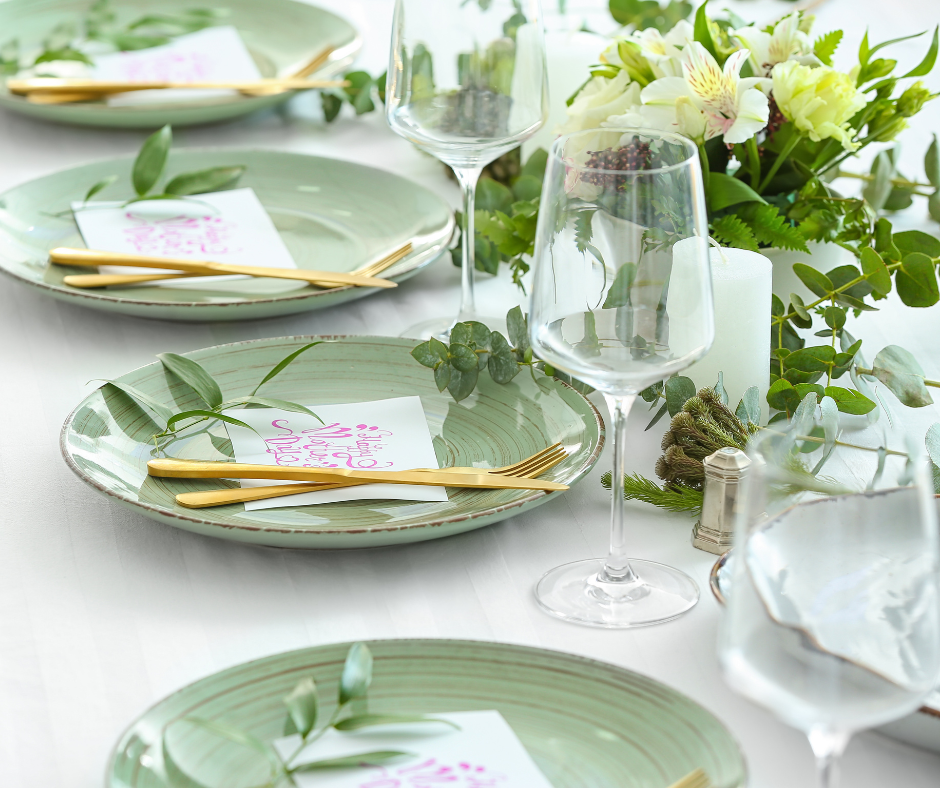
Setting a beautiful table doesn’t require magical skills; all it takes is a little love, patience, and inspiration.
Designing a table setting is a lot like designing a room. Just as interior designers combine objects, colors, and patterns to create a specific mood or feeling, the art of table setting incorporates similar elements.
Like interior design styles, place setting also has its own set of guiding principles.
There are therefore a few things to consider before focusing on the aesthetic aspects of table setting.
Essential Elements to Consider Before Designing Your Tablescape
Whether you are organizing a formal dinner, a buffet, or even a laid-back cocktail party, you must take three main elements into account before you start developing your tablescape design: your menu, the type of event you are hosting, and your guests.
1. The Menu
Your menu will establish the dinnerware and accessories you’ll need for your guests. The number of courses in your menu will also indicate the formality of the event. For instance, a five or seven-course meal is typically more formal than a meal with three courses or less.
2. The Type of Event
Next, consider the formality of the event. Does the occasion require you to host a formal or casual meal? Will it be a sit-down dinner or a more casual gathering where guests can mingle? Also, think about the size of the event—is it a small gathering or a large-scale affair? These factors will help determine your table setting requirements.
3. Your Guests
Take into account the preferences and needs of your guests. The place setting for esteemed clients or your boss will differ from that of a weekend family barbecue. Consider the type of people your guests are, your relationship with them, and any special requirements they may have. Considering these details will make the process of designing the perfect table a lot smoother.
Thinking about these 3 essential elements will help you create a tablescape that’s fitting for the occasion and the guests you are hosting.
Types of Table Setting
Basic VS Casual VS Formal Table Setting: What’s the Difference?
Table settings can be categorized into three main types: basic, casual, and formal. Each type of place setting has its own specific guidelines for placement of utensils, dishes, and glassware to create a cohesive and visually appealing dining experience.
Once you have figured-out the three main elements of your event (menu, type of event, and guests), you are ready to determine which type of place setting would be most appropriate.
What Is a Basic Table Setting?
Basic table setting is simple and relaxed, suitable for everyday meals. As the name suggests, a basic place setting consists of only the basic, or essential elements needed to consume the meal. This usually includes:
- Dinner fork
- Dinner knife
- Spoon
- Dinner plate
- Water glass
How to Set a Basic Table
A basic table setting is the most commonly used setup for everyday meals and informal dinner parties. It also serves as the foundation for more formal place settings.
To create this type of setting, you must start by placing the dinner plate at the center of your place setting. The fork is then placed on the left of the plate, and the knife on the right. The spoon can be placed to the right of the knife. The water glass should be positioned at the top right corner of your plate, right above the knife.
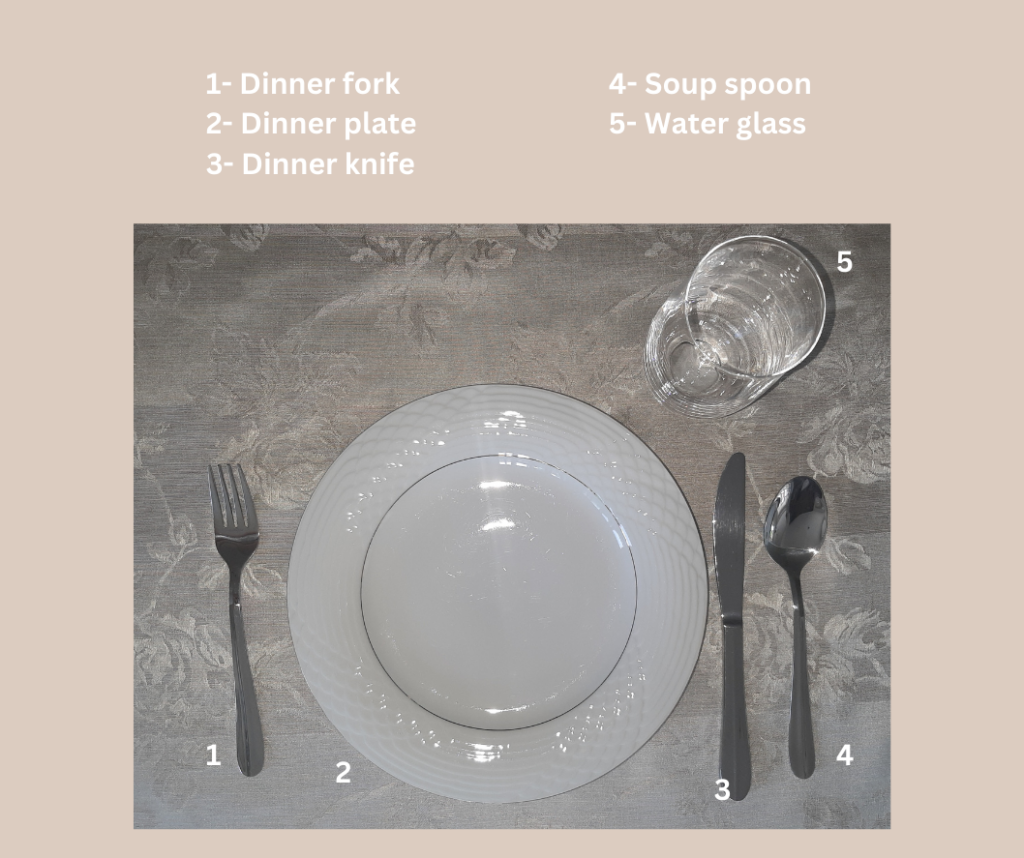
It’s important to note that the term “basic” does not refer to the quality or value of the tableware or even the overall “look” of your tablescape. The most beautiful tablescapes can be created with a basic place setting.
As a matter of fact, here are a few gorgeous examples of how you can elevate this very simple way of setting a table.
The folks at Bless’er House (above) demonstrate how even the most basic place setting can exude elegance.
Jessica Pearsall shows us how a basic place setting can feel bold and oh so beautiful when coordinated with the right colors and accessories.
Finally, Nick and Alicia (below) have beautifully crafted a romantic and dreamy tablescape using only the most basic tableware elements.
Casual Table Setting
A casual table setting starts with the same tableware as a basic place setting, but with a few more elements added to correspond with the meal presented. This usually includes a meal with more than one course, such as a 3-course meal or an even more elaborate menu.
The idea is that the more courses you offer, the more flatware and tableware your guests will need. Items for a casual place setting usually include:
- Salad fork
- Dinner fork
- Dessert fork
- Dinner knife
- Spoon
- Teaspoon
- Salad plate
- Dinner plate
- Water glass
- Wine glass
How to Set a Casual Table
Casual table settings are more elaborate and typically used for special occasions or fine dining. Most families will usually set a casual table setting on holidays.
To set a casual table setting, start by placing the dinner plate in the center. Position the salad and dinner forks to the left of the plate and the knife and spoon to the right. Arrange the water glass above the knife and the wine glass to the right of the water glass. Finally, add a dessert fork and a teaspoon above the plate horizontally.

Casual table settings can have a more relaxed feel or can be of the utmost elegance. Here are a few ideas to use as inspiration.
Barbara from Mantel and Table creates a sophisticated yet casual tablescape fit for royalty. A table like that will make you want to dress up!
The team at Brontë Bride shows us how to elevate casual dining to the next level with a simple yet elegant tablescape that radiates beauty and sophistication:
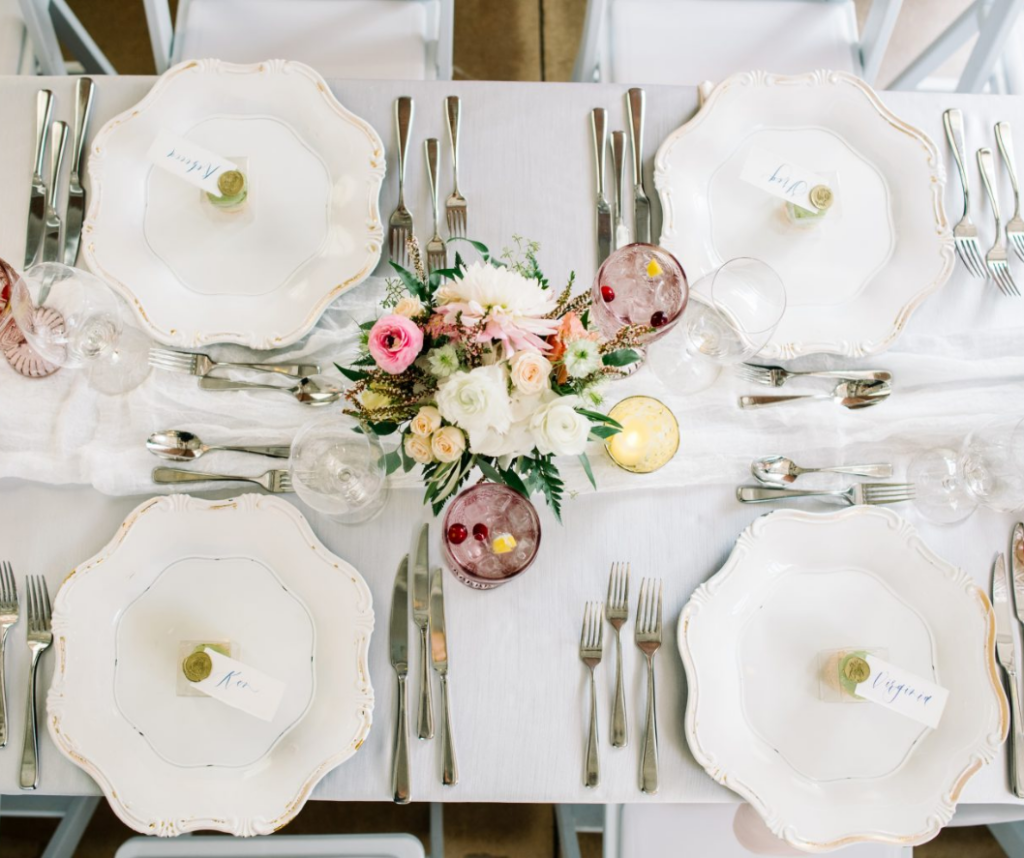
What is Formal Table Setting?
A formal table setting is characterized by several elements that contribute to a refined dining experience, including a multi-course meal served directly from the kitchen, and the observing proper etiquette for formal gatherings. When setting the table, you are essentially providing your guests with the necessary tools to adhere to the proper etiquette for the event.
Many people mistakenly believe that they are setting a formal table every time they use their best china. However, this is not always the case. In reality, the majority people will only get to be seated at a formally set table a few times in their lives.
In a formal place setting, guests are provided with all the necessary flatware, glasses, and dishes they may require for each of the meal’s courses and accompanying wine. These include:
- Salad fork
- Fish fork
- Dinner fork
- Dessert fork
- Dinner knife
- Butter knife
- Spoon
- Teaspoon
- Dinner plate
- Salad plate
- Bread plate
- Soup dish
- Water glass
- White wine glass
- Red wine glass
- Salt and pepper shakers
- Teacup and saucer
Additional tableware, such as a seafood fork, a salad knife, a sherry glass, or a champagne glass, can be added to the formal table setting if the menu or event calls for it. However, since the formal dinner is served directly from the kitchen, additional flatware can be brought in with the serving to avoid overcrowding the table with more than 3 sets of utensils on each side of the plate.
How to Set a Formal Table
In a formal place setting, dinner plates should be placed in front of each chair, one inch from the edge of the table.
Flatware should be placed on both sides of the dinner plate—forks to the left and spoons and knives to the right.
The seafood fork, when needed, can be placed on the right side of the soup spoon. The bread plate is added on the far left and, on the far right, the teacup and saucer; although some prefer bringing the teacup and saucer later on in the evening.
Dessert flatware can be placed on the respective sides of the dinner plate or placed horizontally at the top of the dinner plate. If placed at the top, the teaspoon faces left and the dessert fork faces right (see picture below).
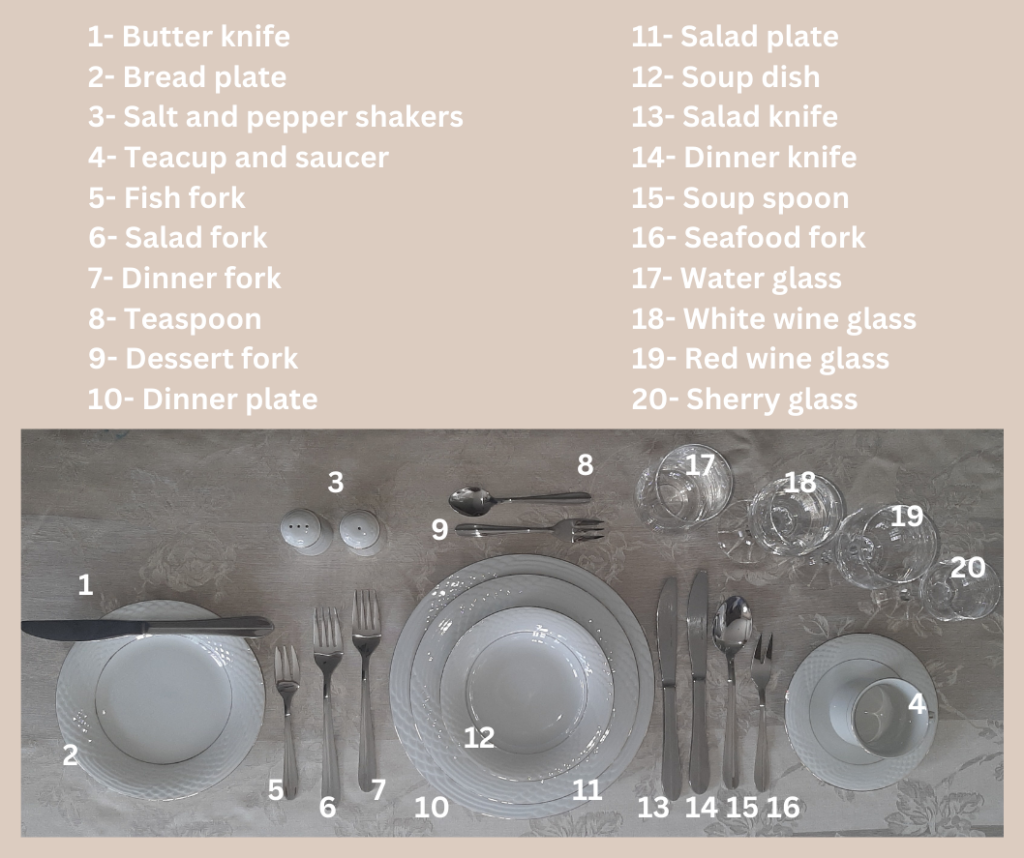
It can clearly be seen why most people do not set a formal table every time they host a dinner party. A formal table setting requires an intricate meal and wine selection that just doesn’t correspond with contemporary traditions.
For example, a classic French meal consists of 13 courses. It’s hard to picture today’s working families going to such an extent every time they host a Friday night dinner with friends! Nevertheless, knowing proper manners and etiquette will help you to play with the guidelines and ultimately, host better dinner parties.
Proper Table Setting
Setting the perfect table for any occasion is a simple yet crucial detail that can elevate your event to the next level. By following the tips outlined in this guide, you can create a beautiful and inviting tablescape that will impress your guests. Knowing the official table setting guidelines also allows you to get creative and have fun with your place settings.
Remember to consider the menu, the occasion, and your guests’ preferences when planning your table setting and selecting your tableware and decorations. Click here for more information on dining etiquette. With a little planning and attention to detail, you can set the perfect table for any event with confidence.
Do you have questions about table setting? Contact me or write me a line in the comments below. I will answer your questions to the best of my ability.
Also, remember to share your beautiful tables #everyday_tablescapes
Talk soon,
The Working Stay at Home Mom
Leave a Reply
heads up!
This site may contain affiliate links. As an Amazon Associate I earn from qualifying purchases. Please read the WSAHM disclaimer page for more information.
The advice on this site is general in nature and will need to be adjusted to your personal situation. If you have any concerns, please consult a trained professional such as your doctor or healthcare provider. More on this here
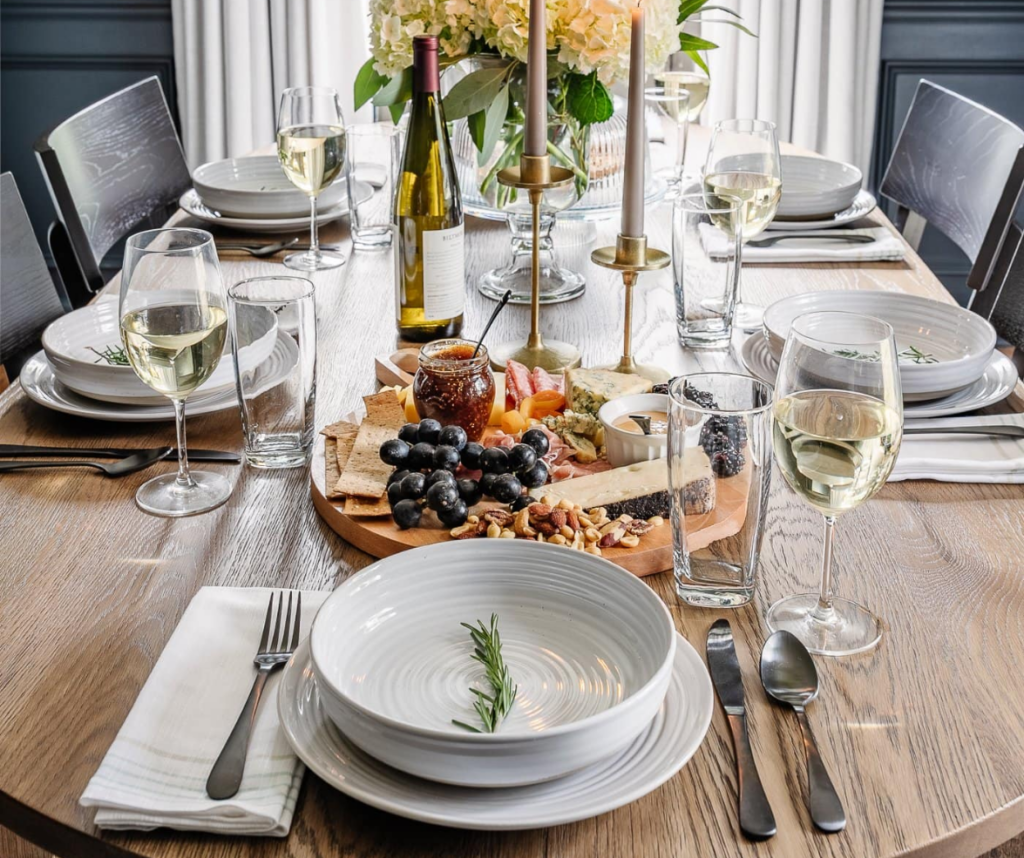
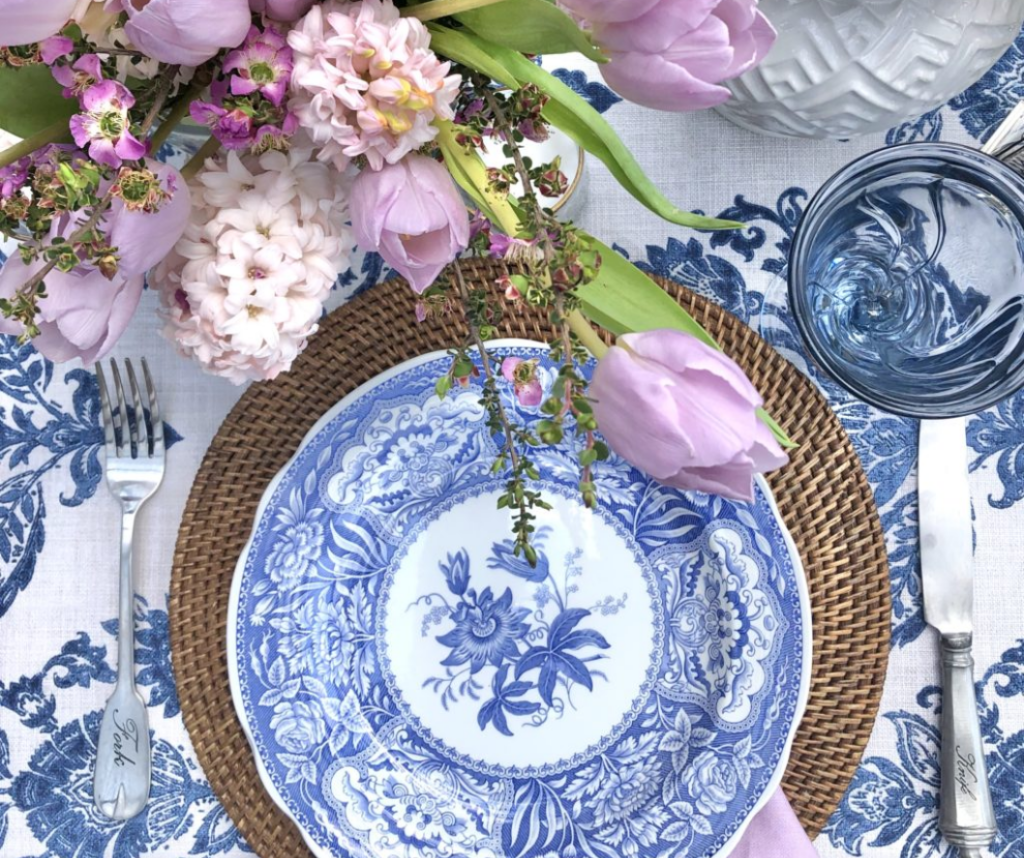
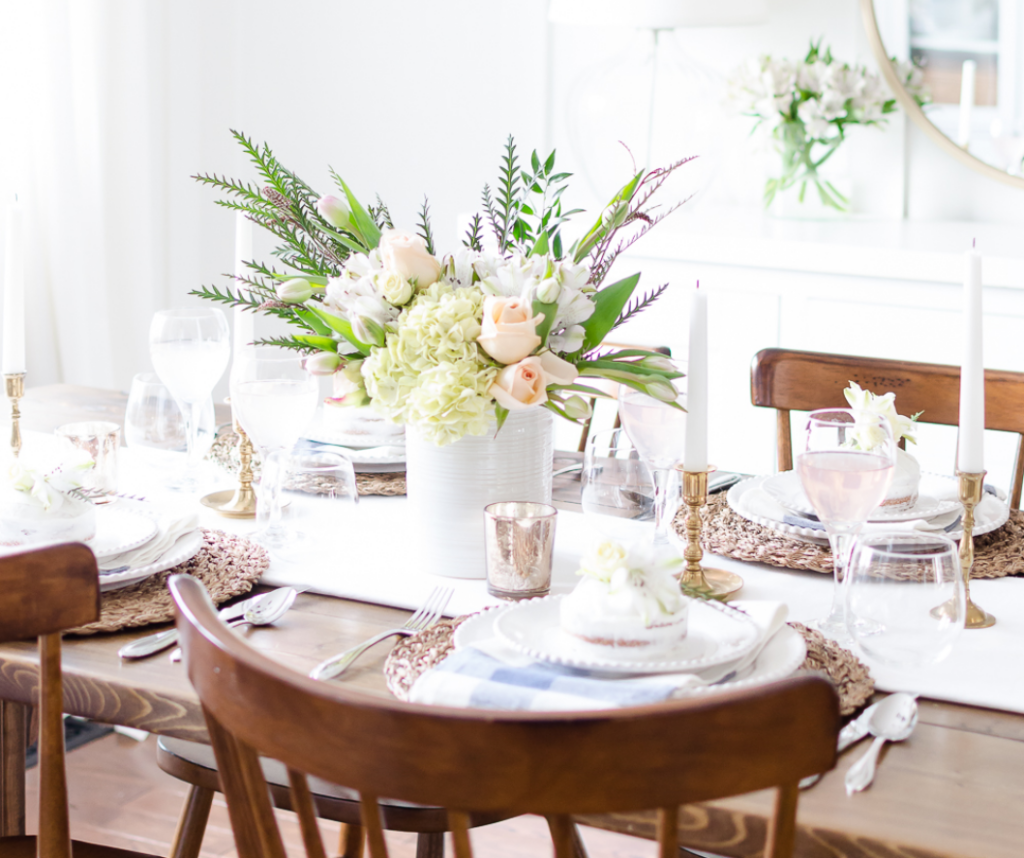
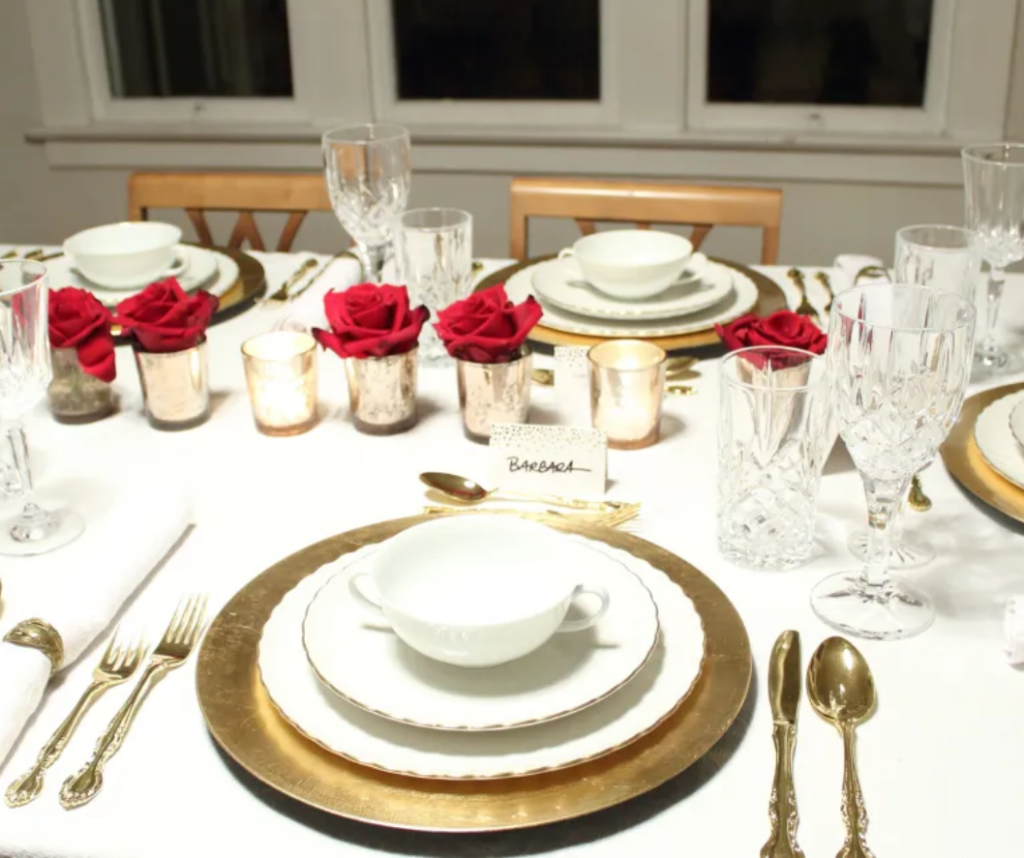
Great article, C! Thanks so much for linking to my formal table setting post – I’m honored to be included! Love your site and all the excellent helpful info for moms at home. Thanks again!
Hi Barbara,
Thanks so much for your comment. Your site (Mantel and Table) is beautiful and the image fits perfectly with the topic, so thank YOU! Stay in touch!
-C (The Working Stay at Home Mom)